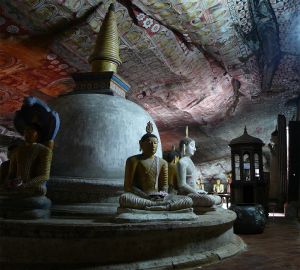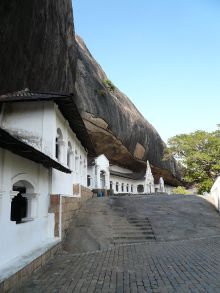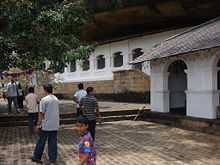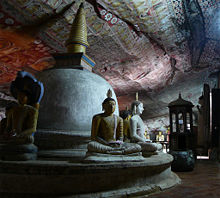Dambulla cave temple
| Golden Temple of Dambulla* | |
|---|---|
| UNESCO World Heritage Site | |

| |
| State Party | |
| Type | Cultural |
| Criteria | i, vi |
| Reference | 561 |
| Region** | Asia-Pacific |
| Inscription history | |
| Inscription | 1991 (15th Session) |
| * Name as inscribed on World Heritage List. ** Region as classified by UNESCO. | |
Dambulla Cave Temple (also known as the Golden Temple of Dambulla) is a world heritage site (1991) in Sri Lanka, situated in the central part of the country. This site is situated 148 km east of Colombo and 72 km north of Kandy. It is the largest and best-preserved cave temple complex in Sri Lanka. The rock towers 160 m over the surrounding plains.There are more than 80 documented caves in the surrounding. Major attractions are spread over 5 caves, which contain statues and paintings. This paintings and statues are related to Lord Buddha and his life. There are total of 153 Buddha statues, 3 statues of Sri Lankan kings and 4 statues of gods and goddesses. The later 4 include two statues of Hindu gods, god Vishnu and god Ganesh. The murals, covers an area of 2,100 square meters. Depictions on the walls of the caves include Buddha's temptation by Mara (demon) and Buddha's first sermon.
Prehistoric Sri Lankans would have lived in these cave complexes before the arrival of Buddhism in Sri Lanka as there are burial sites with human skeletons about 2700 years old ( 700 B.C.E.) which have been unearthed in this area at Ibbankatuwa near Dambulla cave complexes.
City of Dambulla
The city of Dambulla is situated in the Central Province of Sri Lanka, situated 148 km north-east of Colombo and 72 km north of Kandy.
Major attractions of the city include the largest and best preserved cave temple complex of Sri Lanka, and the Rangiri Dambulla International Stadium, famous for being built in just 167 days. The city also boasts to have the largest rose quartz mountain range in South Asia, and the Iron wood forest, or Namal Uyana.
Ibbankatuwa prehistoric burial site near Dhambulla cave temple complexes is the latest archaeological site of significant historical importance found in Dambulla, which is located within 3 kilometers of the cave temples providing evidence on presence of indigenous civilisations long before the arrival of Indian influence on the Island nation.
History of City of Danbulla
The area is thought to be inhabited from as early as the 7th to 3rd century B.C.E.. Statues and paintings in these caves date back to the 1st century B.C.E.. But the paintings and statues were repaired and repainted in 11th, 12th, and 18th century AD. The caves in the city provided refuge to King Valagamba (also called Vattagamini Abhaya) in his 14 year long exile from the Anuradapura kingdom. Buddhist monks meditating in the caves of Dambulla at that time provided the exiled king protection from his enemies. When King Valagamba returned to the throne at Anuradapura kingdom in the 1st century B.C.E., he had a magnificent rock temple built at Dambulla as a gratitude to the monks in Dambulla.
Ibbankatuwa Prehistoric burial site near Dhambulla, where prehistoric (2700 years old) human skeletons were found according to scientific analysis gives evidence on civilisations in this area long before arrival of Buddhism in Sri Lanka. Evidence of ancient people living on agriculture have been detected in this area for over 2700 years according to archaeological findings. (750 B.C.E.)
Dambulla cave temple
It is the largest and best preserved cave temple complex in Sri Lanka. The rock towers 160 m over the surrounding plains.There are more than 80 documented caves in the surrounding. Major attractions are spread over 5 caves, which contain statues and paintings. This paintings and statues are related to Lord Buddha and his life. There are a total of 153 Buddha statues, 3 statues of srilankan kings and 4 statues of god and goddess. The latter 4 include two statues of Hindu gods, Vishnu and Ganesh. The murals cover an area of 2,100 m². Depictions in the walls of the caves include Buddha's temptation by demon Mara and Buddha's first sermon.
Time line of the Caves
- 7th to 3rd century B.C.E.: Early inhabitants
- 1st century B.C.E.: Paintings and statues
- 5th century AD: The stupa was built
- 12th century AD: Addition of the statues of Hindu gods
- 18th century AD: Most of what we see today
- 19th century AD: An additional cave and some repainting
- 20th century AD:UNESCO restoration and lighting
- Dambulla on Google Earth
- Dambulla Guide
- History and Heritage of Sri Lanka
- Unesco World Heritage
- Dambulla Rock Temple
- A list of traditional names for cities in Sri Lanka
| |||||||
Credits
New World Encyclopedia writers and editors rewrote and completed the Wikipedia article in accordance with New World Encyclopedia standards. This article abides by terms of the Creative Commons CC-by-sa 3.0 License (CC-by-sa), which may be used and disseminated with proper attribution. Credit is due under the terms of this license that can reference both the New World Encyclopedia contributors and the selfless volunteer contributors of the Wikimedia Foundation. To cite this article click here for a list of acceptable citing formats.The history of earlier contributions by wikipedians is accessible to researchers here:
The history of this article since it was imported to New World Encyclopedia:
Note: Some restrictions may apply to use of individual images which are separately licensed.


